Abdoulaye Kaba 1, Raed Said 2
1Al-Ain University of Science & Technology, Al-Ain, United Arab Emirates
2College of Business Administration, Al-Ain University of Science & Technology, Al-Ain, United Arab Emirates
Correspondence to: Abdoulaye Kaba , Al-Ain University of Science & Technology, Al-Ain, United Arab Emirates.
| Email: |  |
Copyright © 2012 Scientific & Academic Publishing. All Rights Reserved.
Abstract
The purpose of this paper is to explore how the Arab countries are progressing in developing information society and how they differ in their efforts to build an information society. The researchers are interested to know if there is any relationship between ICT Development Index (IDI) and ICT Price Basket (IPB), as well as the relationship between Gross National Index (GNI) and IDI. The study adopted IDI, GNI, and IPB indicators used by the International Telecommunication Unit (ITU) in 2011. The researchers divided the Arab countries into four groups: GCC, Levant, Magreb, and other Arab countries. Findings indicate a significant progress of the Arab countries, particularly the GCC countries, in developing information society. Results of the study show that countries with relatively high ICT price have relatively low levels of ICT access and use. Similarly, the analysis of the study found that a high GNI for a country results in a high ICT Development Index and vice versa.
Keywords:
Information Society, Information Technology, ICT Development, Arab Countries
Cite this paper:
Abdoulaye Kaba , Raed Said , "Towards an Information Society: The State of the Arab Countries", International Journal of Information Science, Vol. 2 No. 6, 2012, pp. 85-91. doi: 10.5923/j.ijis.20120206.04.
1. Introduction
The use of the term ‘information society’ may be traced back to 1959 when Drucker first mentioned “knowledge worker”[1]. Machlup also made a serious attempt to describe information society in the US by investigating production and distribution of knowledge[2]. Similar studies were found in Europe by studying a shift from goods-based society to information-based society[3]. Earlier literature show no clear definition for the term “information society”[1],[4-6]. Today, most of the scholars and policy makers believe that the advent of information and communication technologies play an important role in building and developing information society[1],[5],[7]. An information society is “a society where work, economic transactions, communications, informationsharing, developing relationships, and interactions involving individuals, organizations, governments, and communities are conducted via information and communicationtechnology (ICT)”[1, p.70]. The concept implies an assumption that information society is different from other types of societies[4].Following the steps of developed countries, developing nations place high considerations on ICT inbuildinginformation society and the Arab countries are no exceptions. Policies of governments through the websites of the ministries, speeches and reports in the Arab world emphasize on developing strategies to become a better information society [8],[9]. For instance, a report by Al-Sudairy in 2010 shows that all the GCC countries have their national ICT strategies and are in the process of establishing the necessary legislative structure to modernize and develop ICT in the government sectors, research and development, education, health and commerce[10].Table 1. Grouping Arab Countries into Sub-regions*
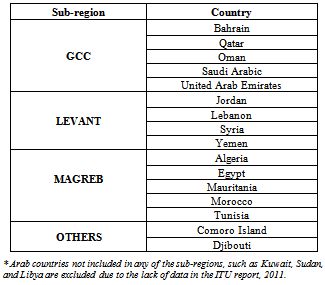 |
| |
|
The main purpose of this paper is to examine, analyze and report the progress of the Arab countries in developing information society. For this purpose the International Telecommunication (ITU) report entitled “Measuring information society 2011” was used and provided sufficient facts and information. For the purpose of comparisons, we divided the Arab countries into four sub-regions as listed in Table 1. The study attempts to investigate the following hypotheses: H1. There are no differences among sub-regions of the Arab countries in regard to the ICT Price basket (IPB). H2. There are no significant differences among sub-regions of the Arab countries in regard to the level of ICT access and use. H3. There is no relationship between ICT Development index and ICT Price Basket of the Arab countries. H4. There is no relationship between GNI and ICT Development Index of the Arab countries. The paper elucidates the nature of commitment of the Arab countries towards developing information society. Results of the study may help understand current efforts and success of the Arab nations in developing information society.
2. ICT Development Index (IDI) and ICT Price Basket (IPB)
The report of International Telecommunication (ITU) entitled “Measuring information society 2011” features two key benchmarking tools to measure an information society: the ICT Development Index (IDI) and the ICT Price Basket (IPB). The IDI captures the level of ICT developments in 152 countries and compares progress made during the past ten years. On the other hand, the IPB combines fixed telephone, mobile cellular and fixed broadband Internet tariffs of 165 countries into one measure and compares them across countries and over time. The IDI and IPB are important in determining the progress of the countries in developing information society. This study is needed for setting-up baseline figures and benchmarks in measuring progress towards developing information society in the Arab world. The sub-regions of the Arab countries with their ranks in the ITU report are presented in Table 4.ICT Development Index (IDI) is a useful tool to benchmark and track the overall progress of countries towards information society. The IDI is a composite index made up of 11 indicators covering ICT access, use and skills as shown in Table 2. It has been constructed to measure the level and evolution over time of ICT developments, taking into consideration, in this study, the situations of the sub-regions of the Arab countries.ICT is one of the most important indicators for the economic growth. In the case of the Arab countries, the ICT usage has been linked to economic factors[7]. As a comprehensive benchmarking tool, the IPB monitors the relative price of ICT services and provides indications of how affordable are services across countries and over time. The IPB indicators used in this study are presented in Table 3.Table 2. ICT Development Index (IDI) indicators
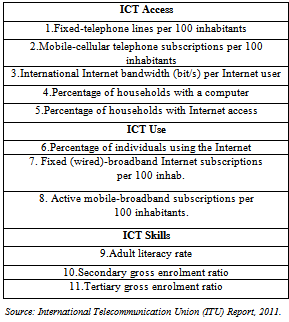 |
| |
|
Table3. ICT Price Basket (IPB) indicators
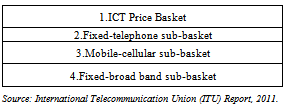 |
| |
|
3. Findings and Discussion
This section discusses IDI ranking for the Arab countries, fixed-telephone, mobile-cellular, fixed broadband of the Arab countries in 2008 and 2010. It also presents and tests four hypotheses stated in the introduction.
3.1. IDI Ranking of the Arab Countries
The Arab countries differ in the IDI values. These differences can be attributed to the income levels of each individual country. The values of the IDI in the Arab countries are ranging widely between 1.8 and 6.19; from which we observed that countries with high-income are on the top among the other Arab countries. More details about the ranking of IDI in the Arab countries are presented in Table 4. This table shows that the overall average of IDI has increased from 3.04 in 2008 to 3.57 in 2010. Precisely we found that both Mauritania and Djibouti lost five positions in 2010 IDI ranking as compared to 2008 figures. On the other hand, Morocco, Oman and Saudi Arabia recorded the highest progress in ranking between 8 to 10 positions.Table 4. ICT Development Index (IDI) ranks for the Arab countries, 2008-2010
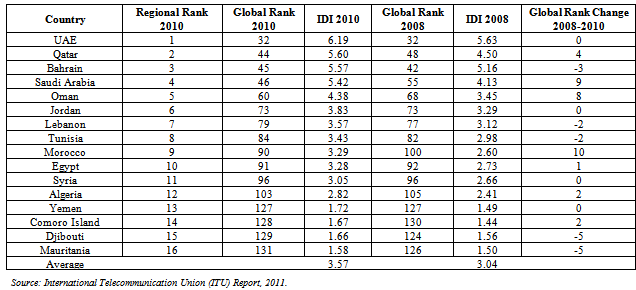 |
| |
|
Table 5. Fixed-telephone cost, 2008 and 2010
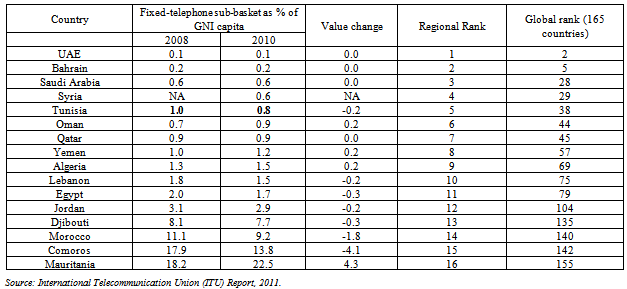 |
| |
|
3.2. Fixed-Telephone
Data of fixed-telephone sub-basket are presented in Table 5. The sub-basket for 2010 includes the price of the monthly subscription plus 30 local calls – half peak time and half off-peak time – of three minutes each[7]. In 2008, the average fixed-telephone sub-basket for the Arab countries corresponds to 4.2 per cent of monthly GNI per capita as compared to 4.1 in 2010, reflecting a decrease of 0.1 per cent.Three of the top five countries with lowest fixed-telephone sub-basket tariffs are members of the GCC countries with high-income economics, these countries are UAE, Bahrain, and Saudi Arabia. Syria and Tunisia came in the fourth and fifth position respectively despite being among the moderate income countries compared to Qatar and Oman which came in the sixth and seventh order. Meanwhile the top five countries with expensive fixed-telephone tariffs in the Arab world are found in the low-income countries. These are Mauritania, Comoros, Morocco, Djibouti, and Jordan. It should be noted that, the above five countries, except Mauritania, reported a decrease of fixed-telephone price between 0.2 to 4.1 per cent in 2010 compared to 2008, while Mauritania witnessed an increase of 4.3 per cent. Six countries have moderate fixed-telephone tariffs. The tariffs for three of these countries, Oman, Yemen, and Algeria, reported an increase of 0.2 per cent in 2010, while the tariffs were decreased by 0.2 per cent in Lebanon and 0.3 per cent in Egypt in 2010. The tariff remained stable for Qatar in 2010.
3.3. Mobile-Cellular
Data of mobile-cellular sub-basket are presented in Table 6. The sub-basket for 2010 includes the price of 30 outgoing calls for peak, off-peak and weekend periods and to the same and other mobile and fixed networks plus 100 SMS[7]. In 2008, the average mobile-cellular sub-basket for the Arab countries was 8.1 per cent of the monthly GNI per capita as compared to 7.5 in 2010. This means that the mobile-cellular sub-basket costs decreased in 2010 by an average of 0.6 per cent as compared with 2008. GCC countries appeared on the top of Table 6 with lowest mobile-cellular sub-basket cost. However, Qatar is the only GCC country which increased mobile-cellular sub-basket tariffs from 1.7 per cent in 2008 to 1.8 per cent in 2010. Meanwhile the most expensive mobile-cellular tariffs countries in the Arab world are found in the low-income countries, specifically Comoros, Mauritania, Morocco, Djibouti, and Syria. It should be noted that, all these countries, except Djibouti, reported a decrease of mobile cost between 2.8 to 9.8 per cent in 2010. While Djibouti, in 2010, witnessed an increase of 0.9 per cent. The remaining six countries, Jordan, Tunisia, Algeria, Lebanon, Egypt, and Yemen, have moderate mobile costs. These countries reported a decrease of mobile tariffs between 0.3 per cent to 1.8 per cent in 2010 compared to 2008 figures.Table 6. Mobile-cellular cost, 2008 and 2010
 |
| |
|
3.4. Fixed Broadband
Data for the fixed Broadband sub-basket are presented in Table 7. In 2008, the average broadband sub-basket for the Arab countries corresponds to 75.4 per cent of monthly GNI per capita as compared to 49.9 in 2010. This means the fixed broadband sub-basket decreased in 2010 by an average of 25.5 per cent as compared with 2008. Four of the top five countries with lowest fixed broadband sub-basket are members of the GCC countries which have high-income economics. These countries are UAE, Bahrain, Saudi Arabia, and Oman. Tunisia came in the fifth position despite being among the moderate income countries compared to Qatar which took the tenth position among sixteen Arab countries. Meanwhile, the most expensive fixed broadband tariffs countries in the Arab world are Comoros, Yemen, Djibouti, Mauritania, and Syria. It should be noted that, the last five countries registered decrease of fixed broadband tariffs, in 2010, between 47.7 to 156.4 per cent. Five countries with a moderate tariff price; Lebanon, Algeria, Egypt, Morocco, and Jordan; registered a decrease of fixed broadband between 0.6 to 4.1 per cent in 2010. Again, the tariff remains stable for Qatar with no change from 2008 to 2010. Table 7. Fixed Broadband, 2008 and 2010
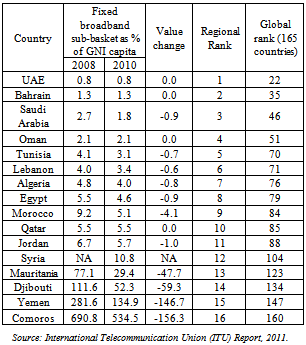 |
| |
|
3.5. ICT Price Basket
Table 8 presents the averages and standard deviations of the ICT Price Basket (IPB) index among different sub-regions of the Arab countries. This table shows very clear differences in the ICT prices among the different sub-regions. Specifically, the table indicates that the price of ICT services in the GCC sub-region is the lowest, with an average of 1.2. The average of prices dramatically increased to reach 8.4 for Magreb countries, 12.5 for Levant countries, and 36.9 for the other Arab countries. On the hand, the standard deviation of the GCC countries is very small (0.88713) compared to the other Arab sub-regions. This indicates that there are no significant differences among the GCC countries in regards to the cost of ICT services. In contrast, high standard deviations, which reached up to 17.25341 for the other Arab sub-regions reveal significant differences among the countries in these sub-regions. Regionally, this may indicates that telecommunication and Internet services in the Arab countries are becoming more affordable.| Table 8. Means and Standard deviations of IDI index of the Arab countries in the different sub-regions |
| | Sub-region | N | Mean | Std. Deviation | | GCC | 5 | 1.2200 | .88713 | | LEVANT | 4 | 12.5000 | 15.76515 | | MAGREB | 5 | 8.4000 | 8.86595 | | OTHERS | 2 | 36.9000 | 17.25341 | | Total | 16 | 10.7438 | 14.65715 |
|
|
3.6. ICT Development Index
The ICT Development Index (IDI) in the Arab countries has significantly increased for the year 2010 as compared with the year 2008 as shown in Figure 1. The very small p-value in Table 9.b which presents the paired samples t-test (p value <0.05) confirms this result as shown in Table 9.a. This table shows that the average of IDI in 2008 (3.034) is significantly different from the average of the IDI in 2010 (3.565) for the Arab countries. Figure 1 confirms this result which shows that the IDI index in the GCC countries is much higher than that in the rest of the Arab countries. | Table 9a. Paired Samples Statistics |
| | | Mean | N | Std. Deviation | Std. Error Mean | | Pair 1 | ICT Development Index (IDI) 2008 | 3.0344 | 16 | 1.29655 | .32414 | | IDI_2010 | 3.5650 | 16 | 1.52282 | .38070 |
|
|
| Table 9b. Paired Samples Correlations |
| | | N | Correlation | Sig. | | Pair 1 | ICT Development Index (IDI) 2008 & IDI_2010 | 16 | .983 | .000 |
|
|
Clearly there is an important heterogeneity in the ICT development across the Arab countries. Further analysis shows that high-income countries are associated with higher intensity level of ICT Development. For example, the IDI level for UAE is 6.19, while this level is around 5.5 for Qatar, Bahrain, and Saudi Arabia. Levant region itself reflects different patterns of diffusion, both between and within countries. Sub-regionally, Lebanon shows higher level of ICT Development than the other non-Gulf countries (see Figure 1). For instance, considering the ITU’s ICT Development Index (IDI) ranks presented in Table 4, Jordan and Lebanon are the better ranked of the Levant countries in 2010 (ranking 73 and 79 respectively), while Yemen is by far the worst ranked (127) after Syria 96.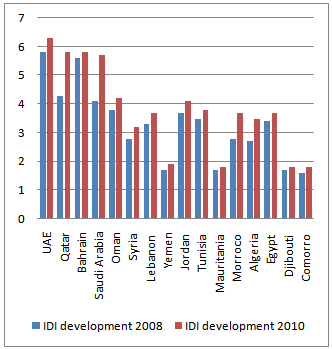 | Figure 1. IDI in 2008 and 2010 |
Table 10. Multiple Comparisons of IDI using Tukey method
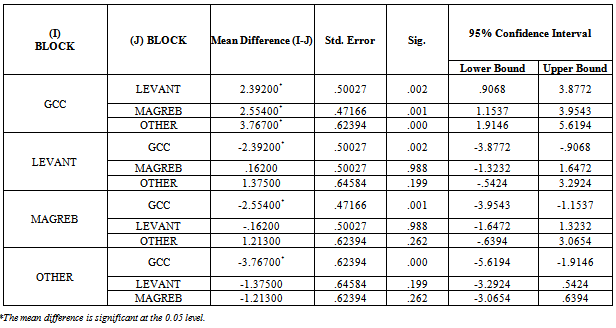 |
| |
|
The multiple comparison results of the PostHoc test, presented in Table 10, shows significant differences among the averages of IDI index of at least two sub-regions of countries in the Arab world. According to these results (p value <0.05), there is a statistical significance in the level of ICT access and use in the GCC sub-region and each one of the other Arab sub-regions.
3.7. Relationship between IDI and IPB
A comparison of the IPB prices with the IDI index of the Arab countries, presented in Figure 2, shows that countries with relatively high ICT Development Index (IDI) have relatively low level of ICT access and use. These results is in line with the ITU findings [7]. The year 2010’s IPB figures of the Arab region reveal a close link between the affordability of ICT services and national income levels. People of the high-income countries pay relatively little for the ICT services; while those in the world’s poorest countries pay relatively more. Figure 3 shows that people living in the GCC countries pay the lowest prices for the ICT services. There are almost moderate prices in the Levant and Magreb sub-regions except for Yemen and Mauritania. In the sub-region of the other Arab countries, mainly Djibouti and Comoro Island, the prices are so expensive to reach as high as USD50 compared to USD2 for the GCC sub-region.  | Figure 2. Relationship between ICT Development Index (IDI) and ICT Price Basket(IPB) |
 | Figure 3. IPB in 2008 and 2010 |
For further investigation, we performed analysis of variance to find out the differences among different Arab sub-regions (GCC, Levant, Magreb and the other Arab countries). The ANOVA table (Table 11) shows that significant differences exist among different sub-regions of the Arab world in the ICT Development Index as well as in the IPB price basket, with p value <0.05. | Table 11. ANOVA Table for IDI and IPB |
| | | Sum of Squares | Df | Mean Square | F | Sig. | | IDI_2010 | Between Groups | 28.111 | 3 | 9.370 | 16.848 | .000 | | Within Groups | 6.674 | 12 | .556 | | | | Total | 34.785 | 15 | | | | | IPB_2010 | Between Groups | 1861.611 | 3 | 620.537 | 5.472 | .013 | | Within Groups | 1360.868 | 12 | 113.406 | | | | Total | 3222.479 | 15 | | | |
|
|
3.8. Relationship between GNI and IDI
As shown in Figure 4, there is a strong relationship between Gross National Income (GNI) and ICT Development Index (IDI). The Pearson correlation coefficient (r = 0.78) confirms this result. This indicates that a high GNI for a country will result in a high ICT Development Index; while the low GNI for a country will result in low ICT Development Index. | Figure 4. IDI and GNI, 2010 |
4. Conclusions
Based on the ITU data[7] used in this study, our findings prove that the Arab countries have achieved, in 2010, a significant progress towards developing information society. This progress can easily be noticed in the GCC countries than the rest of Arab countries. Similarly, results of the study found significant differences among the Arab countries in regard to the ICT Price Basket (IPB). The average of the price for the ICT services in the GCC countries is the lowest, in 2010, as compared to the other Arab countries. This might be because the GCC countries have strong economic and better ICT development strategies than the other Arab countries. Findings of the study show a relationship between ICT Development Index (IDI) and ICT Price Basket (IPB). That means countries with relatively high ICT cost have relatively low levels of ICT access and use. These findings are in line with the ITU report in 2011[7]. Similarly, the analysis of the study found a strong relationship between Gross National Income (GNI) and ICT Development Index (IDI), which means a high GNI for a country will result in a high ICT Development Index; and vice versa. Finally, since this study is based on ICT, IPB and GNI indicators, there is a need for conducting further studies to include more indicators in measuring information society of the Arab countries.
References
| [1] | Ramachandran Ramasamy, “Benchmarking Malaysia in the global information society: regressing or progressing?” Journal of Centrum Cathedra, vol. 3, no. 1, pp. 67-83, 2010. |
| [2] | Fritz Machlup “The production and distribution of knowledge in the United States”, Princeton University Press, Princeton, NJ, 1962. |
| [3] | Lena Tsipouri, “Europe and the information society: problems and challenges for supranatioanl intervention”, Journal of Comparative Policy Analysis, vol. 2, no. 3, pp. 301-319, 2000. |
| [4] | Benjamin J. Bates “Conceptualizing the information society: the search for a definition of social attributes” Paper presented at the 34th International Communication Association Conference, San Francisco, CA, May 1984. Online Available: www.cci.utk.edu/~bates/papers/bates-concept-is.pdf |
| [5] | Frank Webster “The Information Society Revisited”, in Sonia Livingstone and Leah Lievrouw (ed.), “Handbook of New Media: Social Shaping and Consequences of ICTs”, Sage, London, pp. 23-33, 2002. |
| [6] | László Z. Karvalics “Information society-what is it exactly? The meaning, history and conceptual framework of an expression”, in L D. Vinci (ed.), “Society: from theory to political practice,” Network for Teaching Information society (NETIS), Budapest, pp. 1-26, 2007. |
| [7] | International Telecommunication Union (ITU). (2011). Measuring Information Society 2011. International Telecommunication Union (ITU), Geneva, Switzerland, 2011. Online Available: |
| [8] | http://www.itu.int/ITU-D/ict/publications/idi/2011/index.html |
| [9] | Neil McBride, Bernd Carsten Stahl. Egypt’s information society strategy: a critical lexicography. Journal of International Technology and Information Management, vol. 18, no. 1, pp. 1-33, 2009. |
| [10] | David Morgan, “Towards information society-National e-strategies in the Arab world”, 2010. Online available: http://www.yacout.info/Towards-Information-Society-National-e-Strategies-in-the-Arab-World_a1422.html |
| [11] | Fahad Abdullah Al Sudairy, “Impact of ICT on economy and society and quality of life: gulf Cooperation Council region (GCC)”, 2010. Online Available:http://www.stsforum.org/Previous/2010/PL_speach/PL204A_AlSudairy.pdf |





 Abstract
Abstract Reference
Reference Full-Text PDF
Full-Text PDF Full-Text HTML
Full-Text HTML






